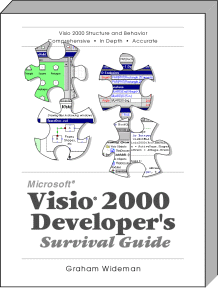| Visio 2000 Developer's Survival Guide Home | |
Fellow developers:
Thanks for stopping by to check out this book. If you're developing with Visio, I think it could save you a great deal of time and head-scratching. This is the book I wish I had when I started trying to figure out the Visio development environment!
Recommended by leading Visio trainers, Visimation, to students attending their Developer classes. |

To order the real-atoms form of the book, please visit this page here.
(Please note that Visio 2000 Developer's Guide is no longer available in downloadable PDF form, as Fatbrain.com has discontinued that service.)
If you want to build robust, maintainable solutions with Visio's ShapeSheet and Automation development environments, you need to understand Visio's structure and behavior. Not just superficially, but in depth. The key challenges are these:
The point of departure for this book is an overview of the Visio environment, and the structures that Visio-based solutions might take. Next, the entire Visio structure is laid out in organized and comprehensive diagrams and tables, so you can absorb it at full speed. Then each major area of Visio structure comes under scrutiny to discover how its behavior can be tamed and harnessed by developers.
This is the bullet-point version, the full Table of Contents is here.
The book page size is 8.25 inches by 11 inches, an unusually large size for computer books, which I selected in order to have room to display lots of information in the form of powerful diagrams and tables. Because information can be presented in such a distilled form using tables and diagrams, you get to what you need faster, and we waste less paper. And although there are numerous ShapeSheet and VBA code snippets, this book is not padded with hundreds of pages of program listings at 20 lines per page. The result is a streamlined and nutritious 350 pages.
You can explore the rest of my sites to find out more, but in brief:
I have over 25 years of experience in electrical engineering, software development, information systems, business analysis and conceptual modeling. In each of these disciplines I mastered the formal diagrams, yet in addition I always found the need to generate drawings automatically, and to extend each diagrammatic convention in formal or informal ways to convey richer sets of detail or summary-level concepts.
Partly to that end, I have been building solutions and tools with diagramming libraries and environments for ten years, and with Visio for over five years. I am also affiliated with the SemNet group centered as San Diego State University. Over the last 15 years this group has produced basic tools for diagramming general semantic networks and formally studying the teaching and learning benefits in making concepts and relationships explicit.
During my experience with Visio, I have increasingly participated in online forums and in beta programs (after one beta, I was thanked for submitting more and better quality bug reports than all other testers combined. A dubious award...). Indeed, you may find me on the Visio newsgroups at msnews.microsoft.com. Once starting on this book project, this past activity helped foster some invaluable input from some of Visio's developer team members. Recently I was recognized with a Microsoft Valued Professional (MVP) award for Visio.
Article Created: 2000-06-09 Last edit: Last edit: 01-03-20 Graham Wideman
Go to: DiagramAntics.com